How to Spend 4 Days in Tokyo- Our Itinerary
Purchases made through links earn us a small commission, at no extra cost to you.
Ah, Tokyo. Just hearing the name conjures up images of densely packed skyscrapers, streets lined with larger-than-life advertisements and crowded public spaces.
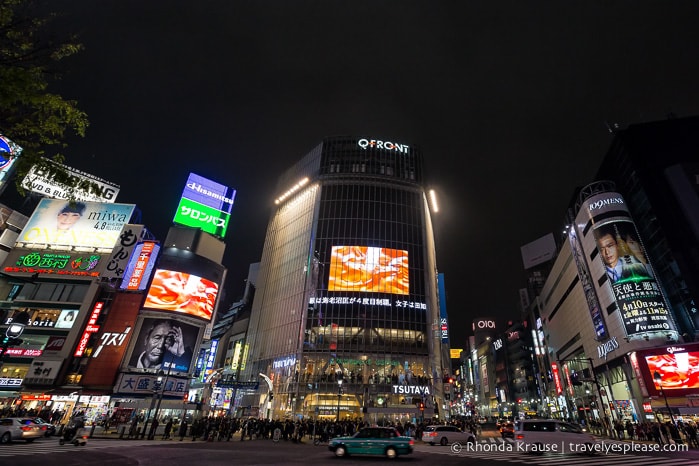
Yes, that vision is correct, but as we discovered during our 4 days in Tokyo, there is much more to the city than first meets the eye.
Tokyo is a city where the past, present and innovations for the future co-exist in perfect harmony.
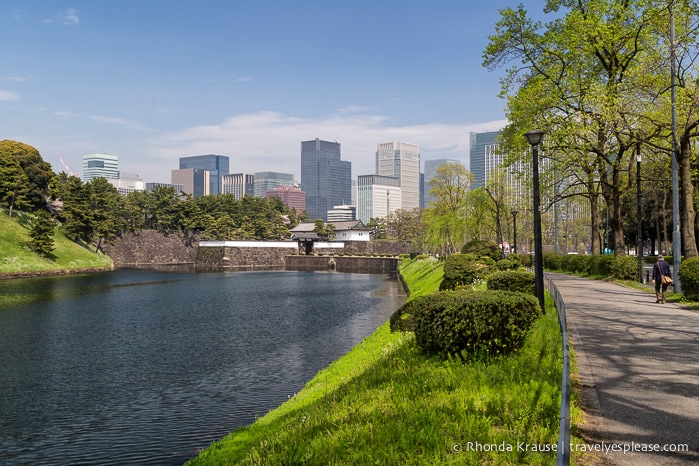
It’s a megacity with something for everyone- an intriguing pop culture, modern architecture, traditional temples and shrines, large parks, quiet gardens, informative museums, high-end shopping, a thriving nightlife and endless opportunities for people watching.
To best experience Tokyo, a multi-day visit is required. I recommend spending at least 4 days in Tokyo to be able to explore numerous districts, plus have time for a day trip outside the city.
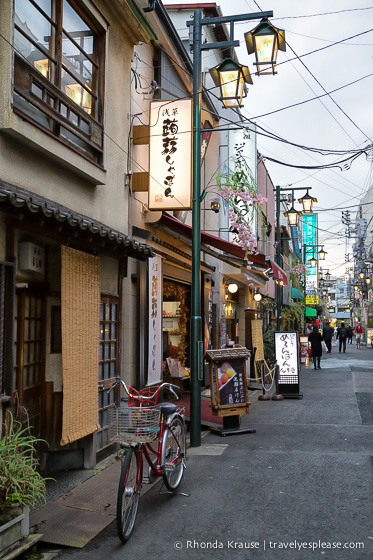
How to Spend 4 Days in Tokyo- Planning Your Visit
During our 4 days in Tokyo, we immersed ourselves in the hustle and bustle, reflected at temples and shrines, took walks in the parks and admired the city from above.
Admittedly, we arrived to Tokyo without much of a plan, not sure what we wanted to see and do. Therefore, our visit was not as efficient as it could have been. We spent a lot of time crisscrossing the city on the subway. Some days I felt like that’s all we were doing!
Tokyo is so big that you should treat it like multiple separate cities (which it sort of is, being made up of 23 special wards). Dividing your visit into zones will make sightseeing more manageable, minimize time spent riding the subway, and make Tokyo seem less overwhelming.
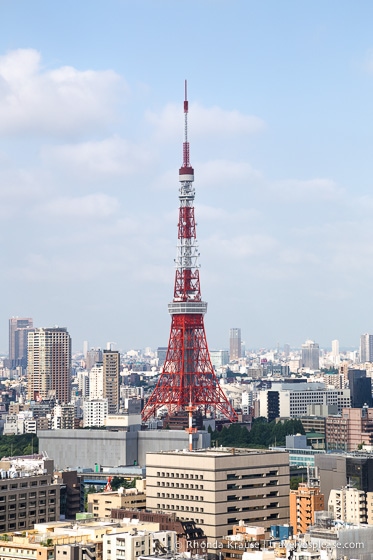
4 Day Tokyo Itinerary- Things to See and Do in Tokyo
I’ve been to Tokyo twice, so the following itinerary contains places I visited on both of my trips. However, I believe we could have seen this all on our original 4 day visit to Tokyo had we been more organized. On our first trip we inexplicably missed out on Meiji Shrine, even though we were right across the street from it (a big regret, so it was the first place I went on my return visit). The Edo-Tokyo museum is the other addition.
Here’s a look at how we chose to spend our 4 days in Tokyo, all conveniently organized into zones- Western Tokyo, Central Tokyo, Northern Tokyo- plus a day trip that is not to be missed! We hope this Tokyo itinerary helps you plan your own 4 day trip to Tokyo!
Note: Links will open in a new window for your convenience
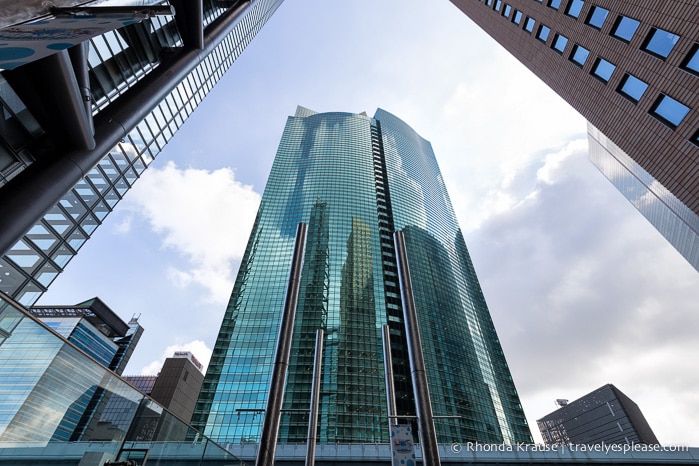
Day 1: Western Tokyo
Neighbourhoods visited: Shibuya, Harajuku, Yoyogi, Shinjuku
Shibuya
To start our visit to Tokyo, we jumped right in and set out to experience the modern, bustling side of the city by visiting Shibuya, one of the busiest neighbourhoods in Tokyo. During the day Shibuya is a trendy shopping area, at night a lively entertainment district.
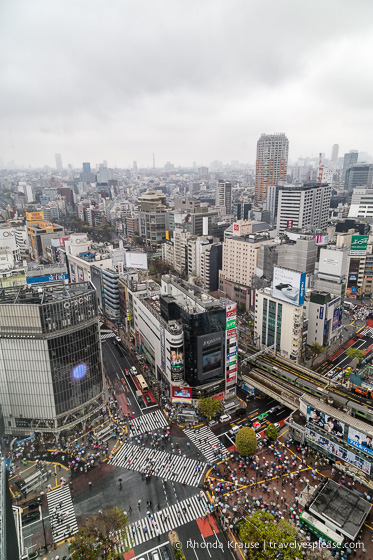
Arriving at Shibuya Station was quite overwhelming as it’s the fourth busiest train station in Japan, handling about 2.4 million passengers on an average weekday. We managed not to get lost and found our way to the Hachiko exit, which is what you want for a memorable first impression of Shibuya.
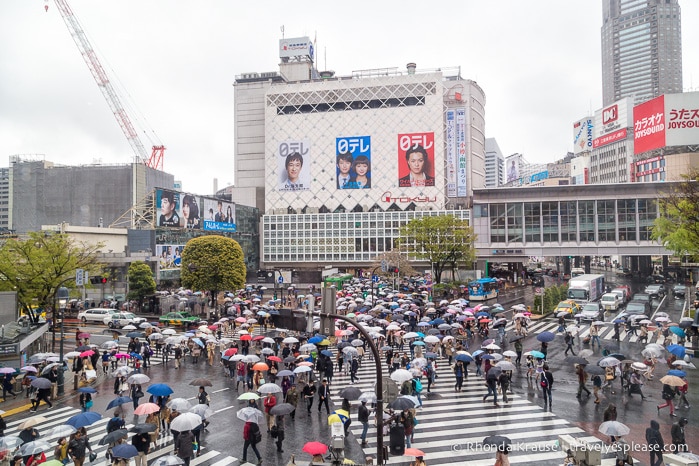
Exiting at Hachiko Square, we were greeted by flashing video screens, bright neon signs, and the famous Shibuya Crossing.
Shibuya Crossing is rumoured to be the world’s busiest intersection and was quite the spectacle, even on a Sunday.
Snagging a window seat at the Starbucks across from the station, we had a prime position to watch the infamous “Scramble”.
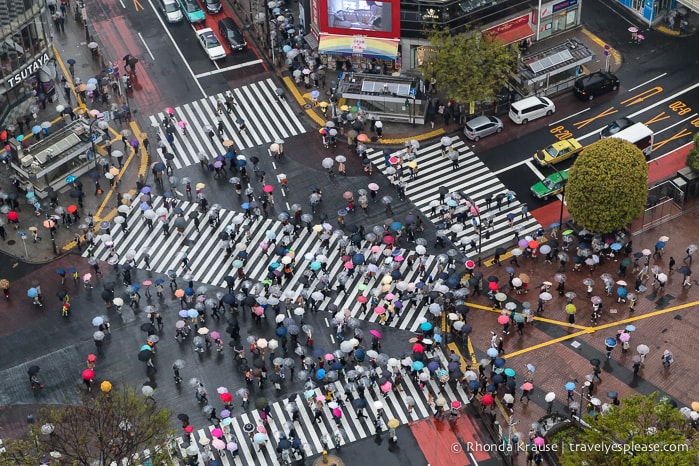
When the traffic lights turn red, people come from all directions to hurriedly cross the street. You’d think it would be chaos, with people walking into each other, but it looked almost like a choreographed dance.
The Shibuya Scramble is definitely one of the best people watching experiences in Tokyo!
Check hotel prices and availability in Shibuya
Harajuku
Moving on to Harajuku, Tokyo’s fashion district, we hoped to see some of the outrageous fashions of teenage Harajuku culture.
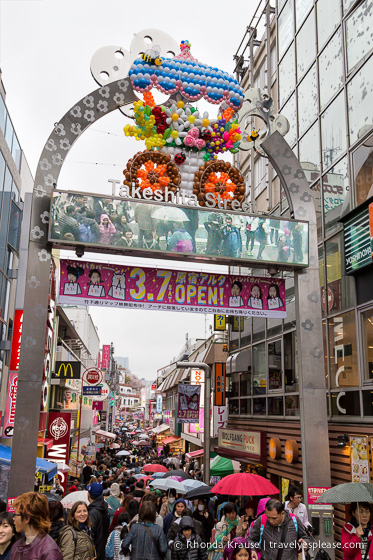
Walking up the narrow alley of Takeshita-dori, we saw shops selling unique clothes and places serving crepes, but mostly it was just shoulder-to-shoulder people. We didn’t even see any Harajuku girls.
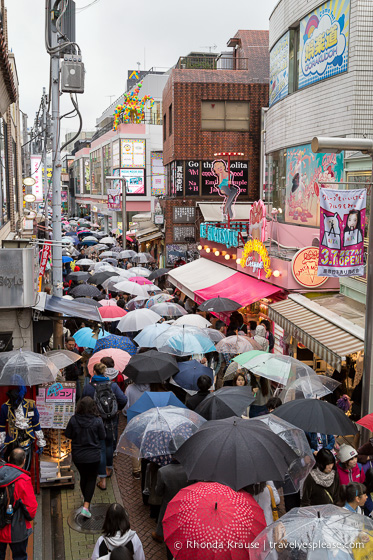
While Takeshita-dori was fun to see, it wasn’t somewhere I wanted to spend a lot of time (too many people!)
Luckily, at the end of the street I could retreat into the forested grounds of Meiji Shrine.
Meiji-jingu (Meiji Shrine)
Meiji Shrine is one of my favourite places in Tokyo and an absolute pleasure to visit in the early morning hours, when very few people are around.
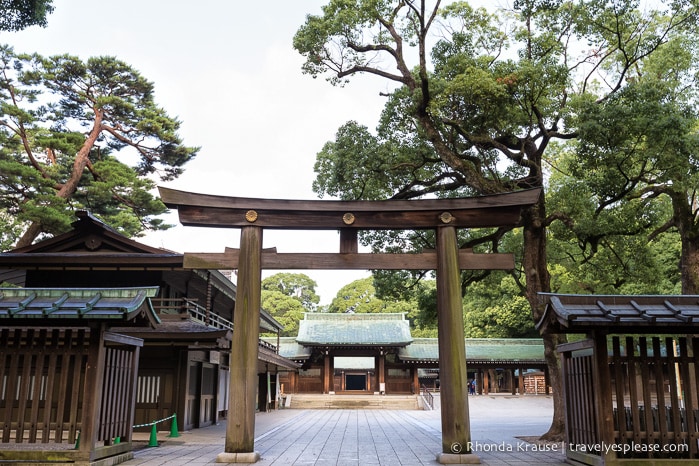
Nestled within a sprawling forest of about 100,000 trees, Meiji Shrine is the perfect place to go when you tire of Tokyo’s modern skyscrapers. Here you can enjoy a relaxing stroll in the shade, connect with nature and experience the traditional side of Japanese culture.
Meiji Shrine is dedicated to Emperor Meiji and Empress Shoken, making it Tokyo’s most important Shinto shrine.
Read my full post about Meiji Shrine.
Tokyo Metropolitan Government Offices- West Shinjuku
West Shinjuku is not that interesting because it’s mainly office towers, but those towers offer fantastic views of Tokyo.
For a view with a price that can’t be beat (it’s free!), we headed up to the 45th floor of the Tokyo Metropolitan Government building. The twin, 202m high towers each have an indoor observatory where you can overlook the city.
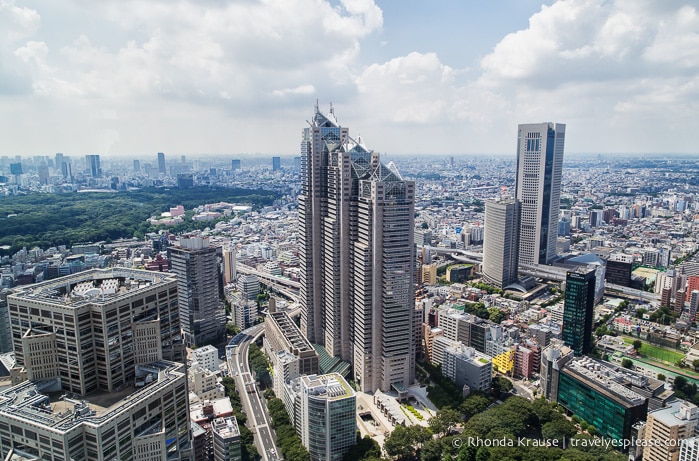
On a clear day you can apparently catch a glimpse of Mt. Fuji, but I never saw it on either of my two visits to the observatory at the Tokyo Metropolitan Government building.
East Shinjuku
East Shinjuku is fun to visit at night when the neon signs cast a glow over the skyscraper-lined streets.
This part of Shinjuku can be thought of as Tokyo’s playground. A centre for nightlife, there are bars, movie theatres, pachinko parlours and restaurants.
If you visit during the day, you’ll be able to browse department stores and perhaps even catch a glimpse of Godzilla fiercely peering over the Shinjuku Toho building and Hotel Gracery.
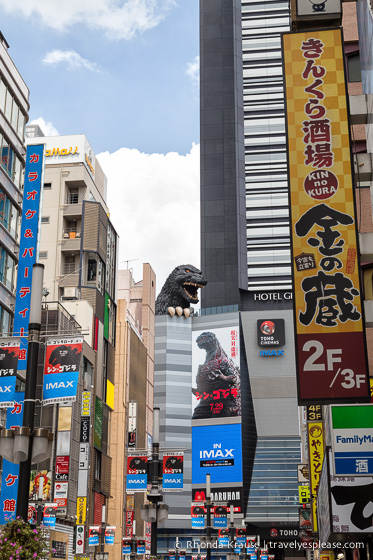
If you’re a true Godzilla fan, you’ll want to go inside the hotel lobby to see the display of Godzilla movie posters throughout the years. Also, if you happen to be there at the top of the hour (from noon-8:00 pm), you’ll witness Godzilla roaring and breathing steam.
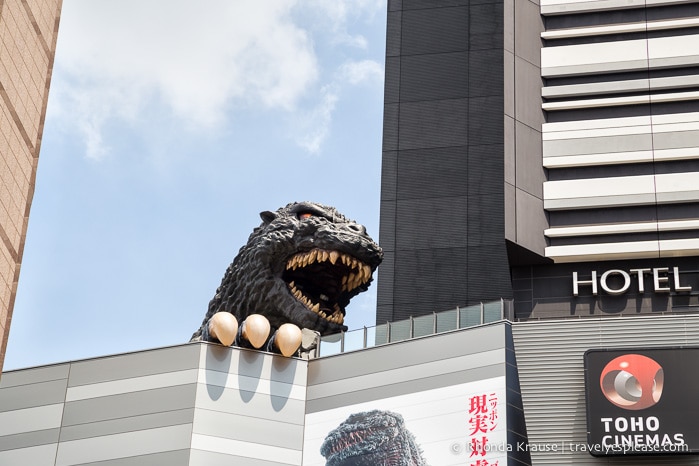
The giant Godzilla head can be found at 1-19-1 Kabukicho and is a 5 minute walk from the east exit of JR Shinjuku Station.
Check hotel prices and availability in Shinjuku
Day 2: Central Tokyo and Tokyo Bay
Neighbourhoods visited: Shibakoen, Marunouchi, Odaiba
Tokyo Tower
We started our second day in Tokyo by heading to Shiba Park to visit Tokyo Tower.
Tokyo Tower is modelled after the Eiffel Tower in Paris, but is taller and, in our opinion, not as elegant. We thought it looked less like a work of art and more like a functional broadcast tower (which it is).
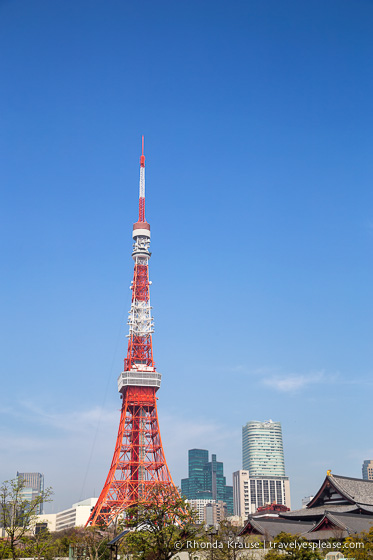
Still, Tokyo Tower was worth visiting because of the two viewpoints overlooking the city- one at 150 metres and the other at 250 metres. We went up to both viewing levels (the top one has the best views) and got a good sense at just how big Tokyo is. The city was sprawled out as far as we could see!
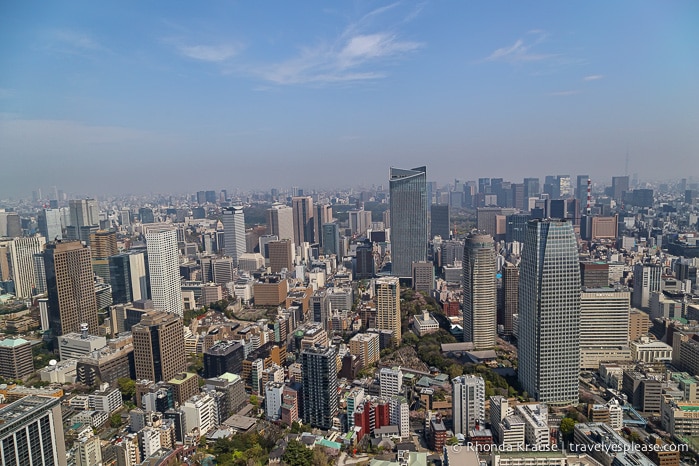
Tokyo Imperial Palace
Next we made our way to the Imperial Palace, which is where the Emperor and his family live.
I knew the palace wasn’t open to the public, but was surprised to find out that the East Garden of the Imperial Palace was closed as well (it was a Monday. The garden is also closed on Fridays).
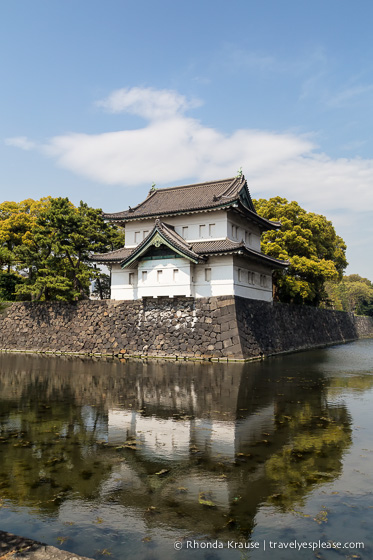
Disappointed, we instead walked around the perimeter of the grounds. It actually was quite nice to stroll alongside the moats and stone walls.
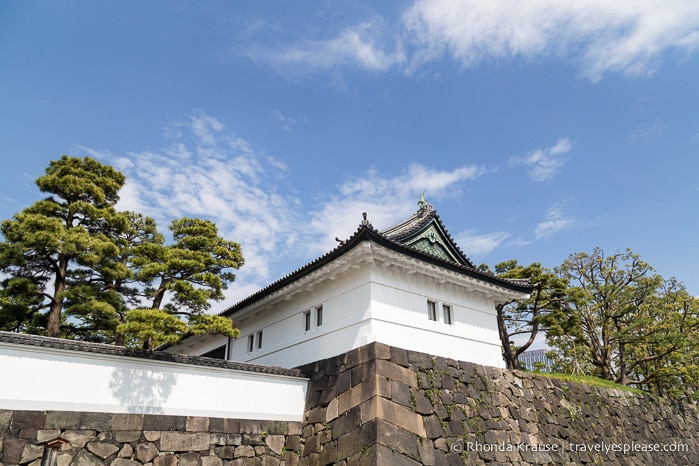
Soon we came to the Nijubashi, a double-arched stone bridge that serves as the entrance to the inner palace grounds. From the bridge, you can even catch a glimpse of the Imperial Palace.
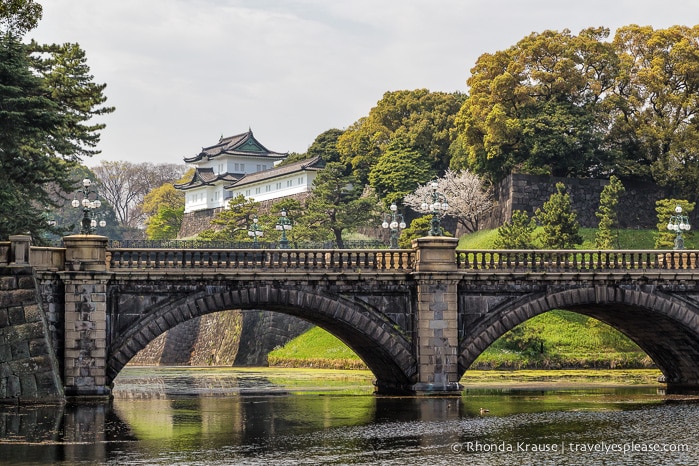
Update: I’ve since been back to Tokyo and was able to visit the Imperial Palace East Gardens. The highlight was the Ninomaru Japanese garden- so beautiful!
Tokyo International Forum
While not a major tourist attraction, the Tokyo International Forum is worth visiting if you appreciate architecture. The ceiling of the glass atrium resembles a ship’s hull, making it one of Tokyo’s most distinctive buildings.
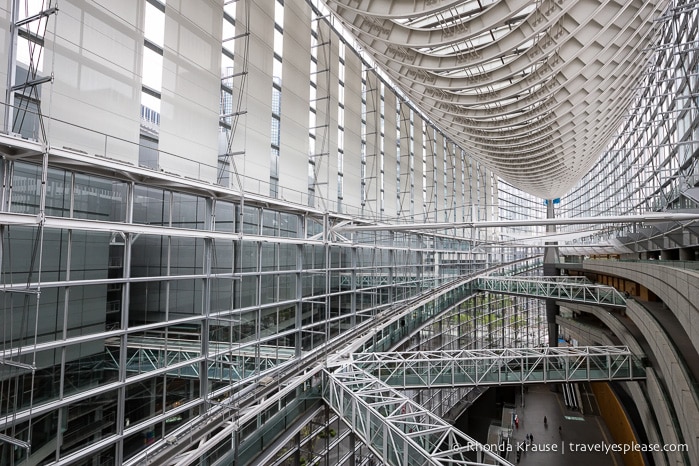
Check hotel prices and availability in Central Tokyo
Odaiba & Tokyo Bay
As evening approached, we made our way across Tokyo Bay to the island of Odaiba (Daiba).
To get there, we took a surprisingly fun ride on the driverless Yurikamome monorail. Sitting in the front seat, we got fantastic views of the city’s night lights as the train looped above the harbour then crossed Rainbow Bridge. I felt like we were riding into a theme park!
We spent most of our time in Odaiba along the waterfront, going for walks and enjoying a meal at as we gazed across the bay. There is a small replica of the Statue of Liberty here but I was most enamored with Rainbow Bridge and its backdrop of city lights. Tokyo sure is beautiful at night, especially when viewed from Odaiba!
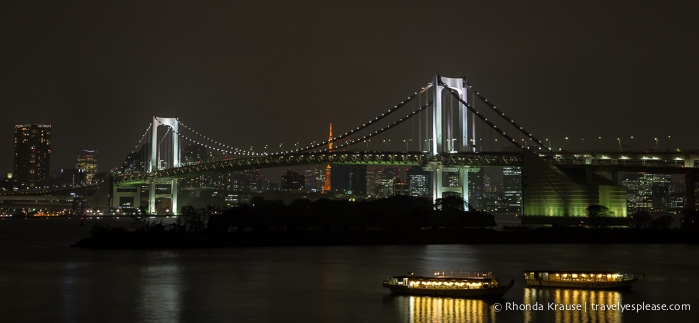
We wish we arrived to Odaiba earlier in the day because we really liked the feel of this area of Tokyo. Next time, I want to ride the Ferris wheel at Palette Town and get some pictures of the futuristic-looking Fuji TV building.
Update: Palette Town is undergoing a major redevelopment starting in 2022, so many of its attractions will be closing, including the Ferris wheel.
Check hotel prices and availability in Odaiba
Day 3- Northern Tokyo
Neighbourhoods visited: Ryogoku, Ueno, Asakusa, Oshiage
Edo-Tokyo Museum
Normally I don’t like to visit museums on my travels, but the Edo-Tokyo Museum was one I’m glad I decided to explore.
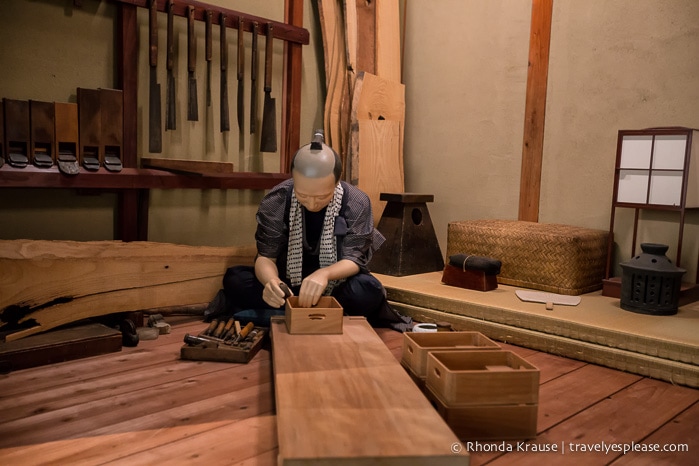
The Edo-Tokyo Museum captured my imagination with its scale-model dioramas, automated exhibits, miniature townspeople figurines and large-size building replicas. It was a fun and engaging place to learn about Tokyo’s transition from the Edo period to present day metropolis.
Update: The Edo-Tokyo Museum will be temporarily closed for renovations from April 1, 2022 until possibly spring of 2026. The entire facility will be renovated including displays, equipment and more.
Read my full post about the Edo-Tokyo Museum.
Check hotel prices and availability in Ryogoku
Ueno Park
Ueno Park is packed full of attractions and you could spend a lot of time here, if you so choose.
There are temples, shrines and multiple museums, including the Tokyo National Museum, National Science Museum and Tokyo Metropolitan Art Museum.
We decided to stroll around outside, passing by a few statues, ponds and hundreds of cherry trees.
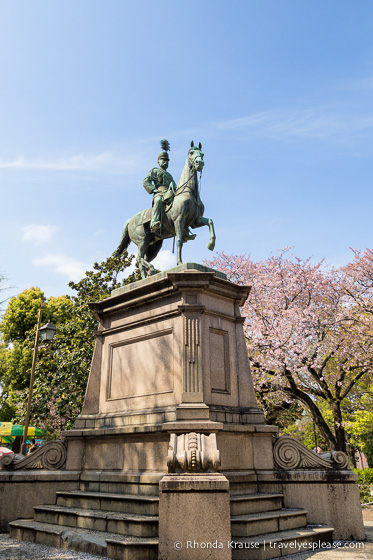
Ueno Park is also home to Japan’s oldest Zoo, Ueno Zoo. I have mixed feelings about zoos but ultimately we decided pay a visit because I’ve always wanted to see giant pandas.
Ri Ri and Shin Shin are Ueno Zoo’s biggest attraction and I couldn’t help but smile as I watched them happily munch on bamboo stalks. So darn cute and wow, do they ever eat a lot!
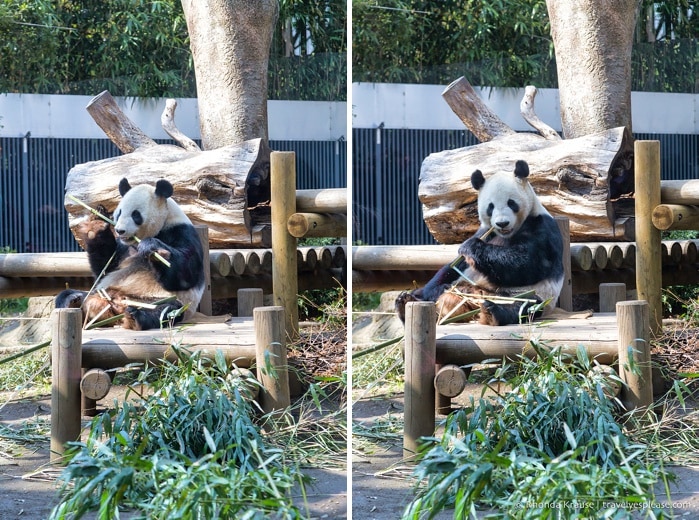
We visited some of the other animals, but I was feeling uneasy about how small some of the enclosures were, so we decided to head to the exit.
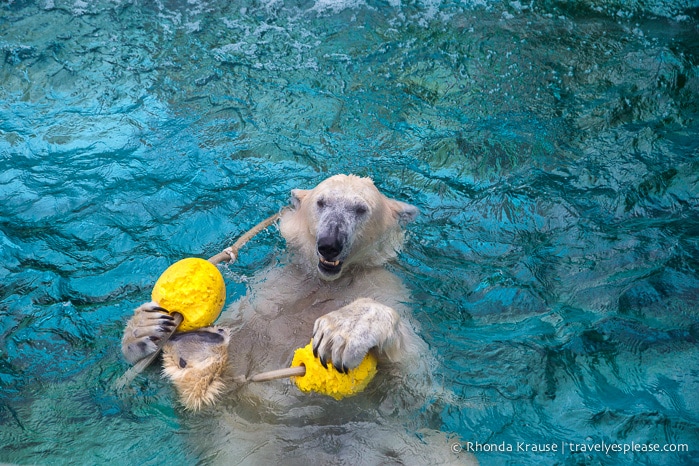
On our way out though, we had to stop and say hi (okay, it was more like “I love you”) to the red panda. My favourite animal, the red panda always charms me with its adorable face. I just want to scoop it up and cuddle with it forever!
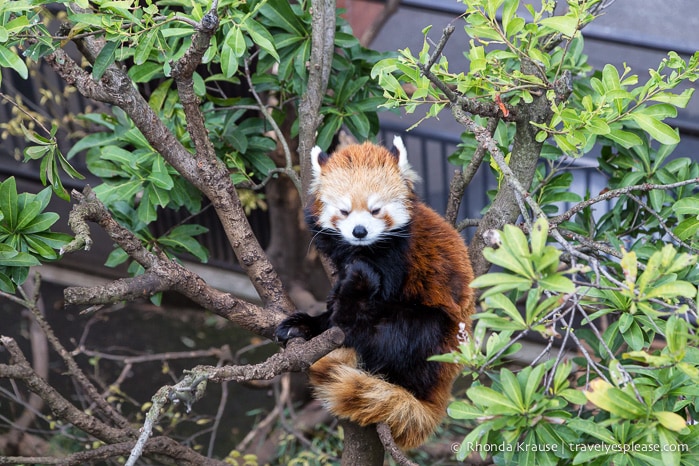
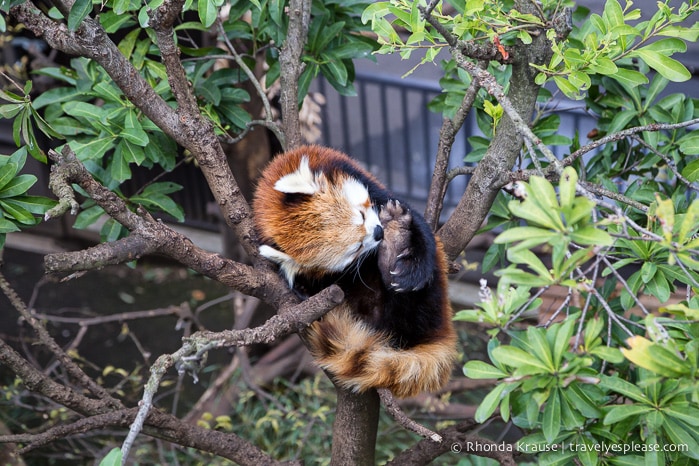
Check hotel prices and availability in Ueno
Senso-ji Temple
After Ueno Park, we went to the Asakusa district to see Senso-ji, Tokyo’s most visited temple, and in my opinion, most spectacular thanks to the five-story pagoda and huge red paper lantern at the gate.
Senso-ji Temple is very busy during the day so there are plenty of opportunities to witness people engaging in traditional rituals, such as wafting smoke over them from the large incense burner.
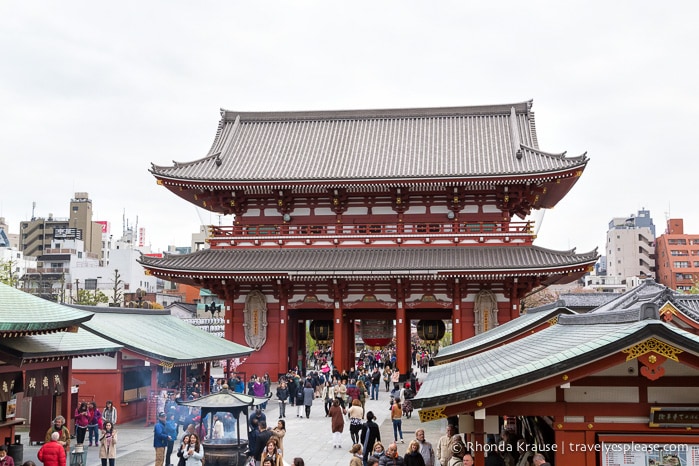
On my second trip to Tokyo, I returned to Senso-ji at night and it was a completely different experience. There were no crowds, the grounds were quiet and the buildings looked even more dramatic when lit up by lights.
Read my full post about Senso-ji Temple.
Sumida River
From Senso-ji Temple, we walked to nearby Sumida River to take in the nice views of the Tokyo Skytree.
As we crossed the river on our way to the Skytree, we had to wonder and laugh about the interesting architecture of the Asahi Breweries headquarters!
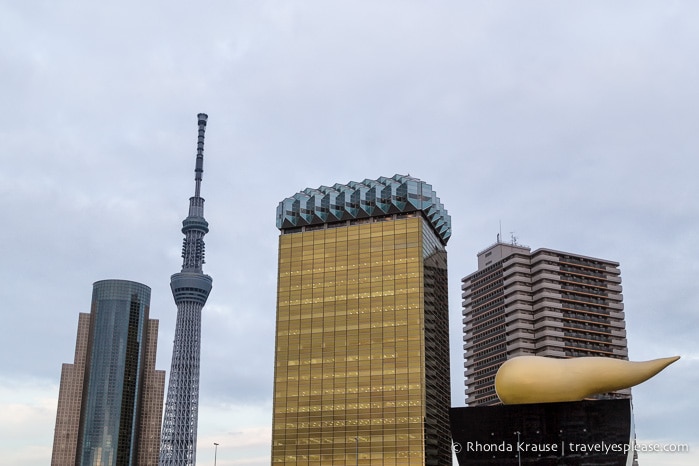
Tokyo Skytree
We ended our last full day in Tokyo by going up the Tokyo Skytree, the tallest tower, and second tallest structure, in the world.
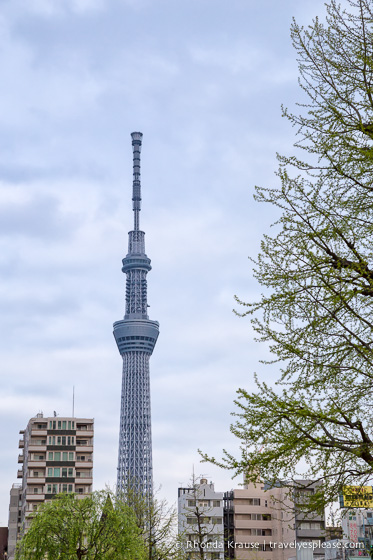
I loved visiting the Tokyo Skytree after dark since it gave us a different perspective of the city, which we had previously seen from above only during the day.
We got a ticket to go up to the highest level (450 metres), but I don’t think it was worth it since the view from the main observation deck (350 metres) was just as great.
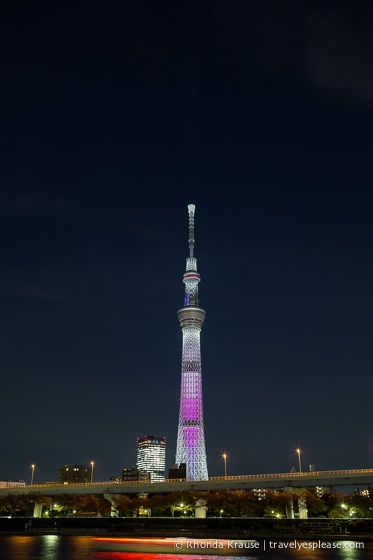
Besides the fantastic views, I appreciated that photographers are allowed to use tripods, so I got some good photos of Tokyo at night, even when shooting through glass.
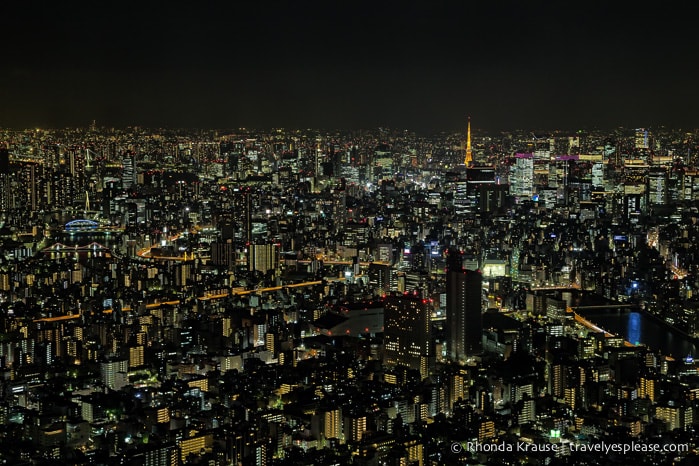
We were hoping to eat supper at the top of the Skytree, but the restaurant was already closing. Instead we went to a different tower of the Skytree Town (a complex of restaurants, shops and other attractions) to eat a late dinner. It was actually pretty cool to eat where we did because all the tables were set up to face the Skytree, so we got to admire it while we ate.
Check hotel prices and availability in Asakusa
Day 4- Day Trip to Nikko
For our last day in Tokyo we decided to do a day trip to Nikko. A forested area dotted with temples and shrines, Nikko was a welcome break from the towers and crowded streets of Tokyo.
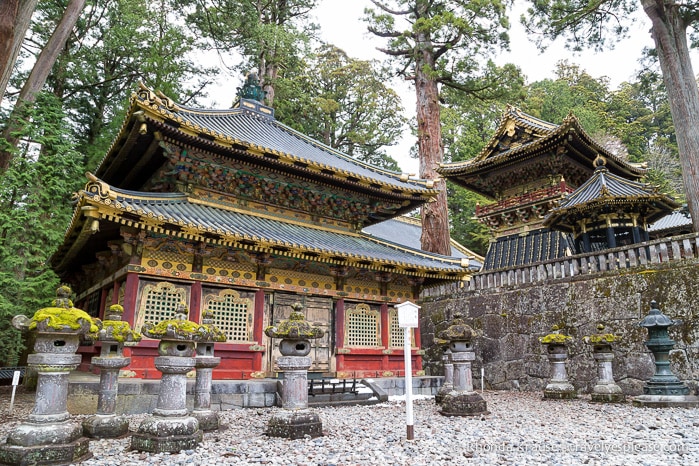
We had a fabulous day exploring Nikko’s sacred areas and taking walks in nature, but the highlight was visiting the surprisingly lavish Nikko Toshogu Shrine.
Read my full post about our day trip to Nikko.
Final Thoughts on Our 4 Days in Tokyo
It took me a while to warm up to Tokyo but eventually I did come around to liking it. After two visits, I now consider it to be one of the world’s greatest cities and best places in Japan to visit.
We liked how Tokyo had something to please both of us. There were high-rises, a fast-paced atmosphere and quirky pop-culture for Mike, along with pockets of nature, spiritual spaces and traditional architecture for me. Getting to experience the effortless mix of old and new, man-made and nature, is just one reason why we think Tokyo belongs on a Japan bucket list.
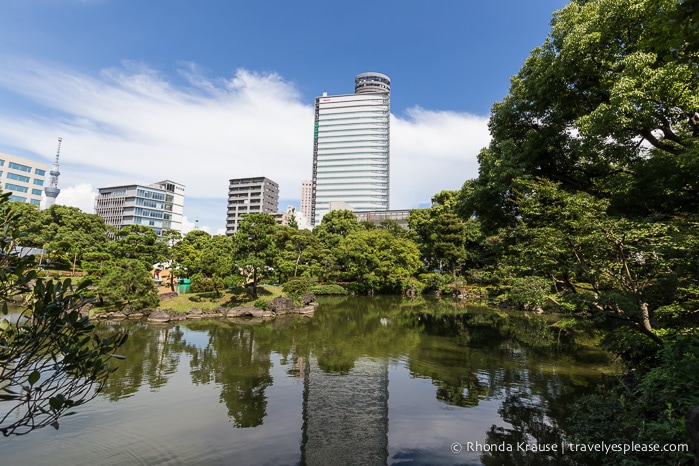
What was most impressive, however, was how clean and efficient Tokyo was. Litter on the street was almost non-existent and public transportation (coupled with a culture of order and respect) enabled millions of people to move around the city with ease.
Sprawling in size, Tokyo can at first be overwhelming. It requires some thoughtful planning to make the most of your time, but it’s a city you could visit over and over again and always discover something new!
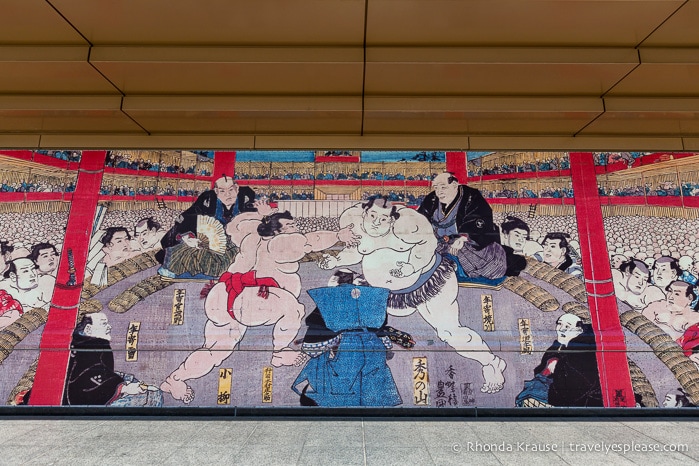
More Places to See in Tokyo
Since writing this post, I’ve made a third trip to Tokyo and have a few more places I’d recommend adding to your Tokyo itinerary.
Shinjuku Gyoen National Garden
I absolutely loved Shinjuku Gyoen National Garden in East Shinjuku. I spent an entire afternoon strolling around the park and its different gardens, even finding some early blooming cherry trees. In my opinion, this is Tokyo’s most beautiful park, way prettier than Ueno Park.
Nezu Shrine
Nezu Shrine is under the radar of most tourists so it’s a pleasant place to visit if you want to avoid crowds. It’s one of Tokyo’s oldest shrines and features a tunnel of small torii gates and hillside of azalea bushes. Nezu Shrine is in the Bunkyo ward, an easy 20 minute walk from Ueno Park.
Read my full post about Nezu Shrine.
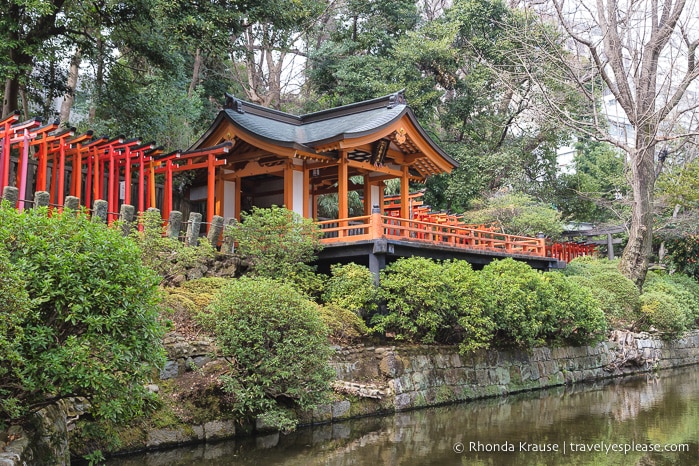
Tips for Visiting Tokyo
Getting to and from the Airports:
- Tokyo has two major airports- Narita and Haneda. I’ve flown into both and preferred Haneda because it is way closer to the city centre than Narita (which is 66 kms away from central Tokyo).
- Narita Airport: The fastest and (usually cheapest) way to get to the city is by train. We took the Narita Express to Tokyo Station and it took a little less than an hour. The Narita Express also goes to Shinjuku, Shibuya and Shinagawa stations. Trains run every half-hour and tickets can be bought in the airport terminals. Japan Rail Pass holders can ride for free.
- Limousine buses leave hourly and shuttle visitors to major hotels and train stations. Plan to spend 1.5- 2 hours on the bus.
- If you prefer to use a shared transfer/shuttle van for direct to hotel service, here is where you can book a transfer to/from Narita Airport.
- Don’t take a taxi from Narita airport- it will cost a fortune!
- Haneda Airport: I used the Tokyo Monorail (free with a JR Pass) to get from Haneda airport to Hamamatsucho station on the JR Yamanote line. It takes about 15 minutes. Once on the Yamanote line you can get to the major train stations.
- Limousine buses leave hourly and stop at major stations like Shibuya, Shinjuku and Tokyo. Buses operate between 5:00 am and 12:30 am.
- If you’d like to use a shared transfer/shuttle van for direct to hotel service, here is where you can book a transfer from Haneda Airport.
Using the Subway in Tokyo:
- Tokyo’s subway system is a massive network, but the colour-coded maps and bilingual signage make it very easy to use.
- The subway is operated by two different companies. Tokyo Metro operates nine lines and Toei operates four. It’s important to note which group you will be using, as they require separate tickets.
- It’s easy to purchase tickets as the machines have an English option. You can buy single fare tickets or choose from a few day pass options. The machines accept coins and bills.
- Fares are determined according to how far you ride and are displayed on the large map above the ticket machines. If you are not sure how much to pay, just buy the least expensive ticket and use the fare adjustor machine at the exit gate of your destination station to pay the remaining amount.
- Instead of buying individual tickets, you can get a Suica or Pasmo Card. This prepaid card is valid on all subway, local rail and bus lines in Tokyo (and most regions in Japan). Simply touch the card to the electronic reader and the cost of your trip will be debited. The Suica and Pasmo cards can be reloaded with more yen if needed.
- You can also buy a Tokyo Subway Ticket. Tickets include unlimited access to all Tokyo Metro and Toei Subway lines and are valid for 24, 48, or 72 consecutive hours. They can be purchased online here (you will be sent a QR code that needs to be exchanged for a physical ticket at a ticket vending machine in major stations).
- Tokyo’s subway can be very busy and crowded (especially between 8:00 am-9:30 am and 5:00 pm-8:00 pm). Be prepared to have to stand shoulder-to-shoulder with other commuters.
- People are very quiet on subways and trains. Follow the locals’ lead and refrain from talking loudly and using your cell phone.
- The Japanese make orderly line-ups when waiting for the subway (it’s marked on the platform where the doors will be when the train stops). When the train doors open, people will move aside and stand along the train, making it easy for passengers to get off.
- The whole subway system in Tokyo shuts down around midnight until 5:00 am.
- There are subway cars that are designated for women only.
Taking the Train (Japan Rail) in Tokyo:
- In addition to the subway, Japan Rail also operates within the city. The JR Yamanote line makes a loop around Tokyo and stops at the city’s main hubs including Shinjuku, Shibuya, Shimbashi, Tokyo and Ueno stations. We used this line a few times during our 4 days in Tokyo.
- If you have a Japan Rail Pass (purchase online here) you can travel for free on the Yamanote line, the Narita Express (serves Narita airport), the Tokyo Monorail (serves Haneda airport), and a few other JR lines that cross the city.
- Get an eSIM from Airalo so that you have access to affordable data for checking train schedules on the go.
Credit Cards and ATMs:
- Most places in Tokyo take credit cards (but not all taxis). We had no trouble using them at hotels and restaurants.
- Our bank cards worked fine at ATMs in Tokyo. The best place to find ATMs that work with foreign debit cards is at 7-Eleven. You can also find English ATMs at Post offices, but they are closed on evenings and weekends.
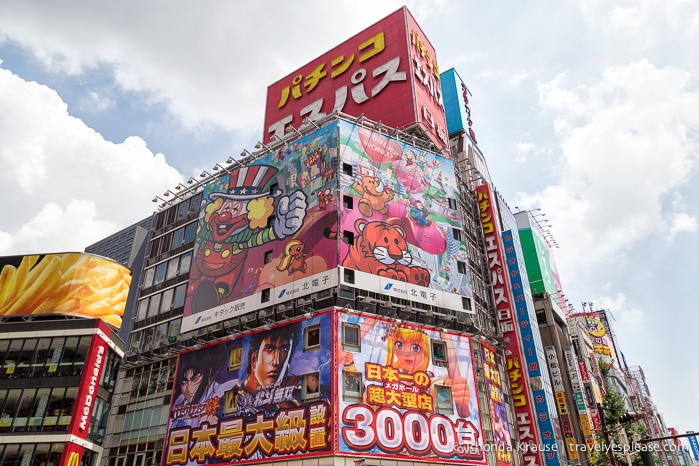
Tours in Tokyo
Here is a trusted site that has a huge inventory of tours and tickets for activities in Tokyo. You can book everything from themed walking tours, cooking classes, shows, bike tours, cultural craft and art experiences, day trips out of the city, and private tours with a local.
Accommodations in Tokyo
For your convenience, here is a list of hotels in Tokyo. Please consider booking your Tokyo accommodations through the included link. It costs nothing extra and helps support this website. Thank you!
More Japan Destinations and Travel Guides
- Two Weeks in Japan- Our Itinerary’s Hits and Misses
- How to Spend 3 Days in Kyoto- Our Itinerary
- Jigokudani Monkey Park- See Hot Spring Loving, Wild Snow Monkeys in Japan
- Best Temples in Japan- My Favourite Japanese Temples to Visit

